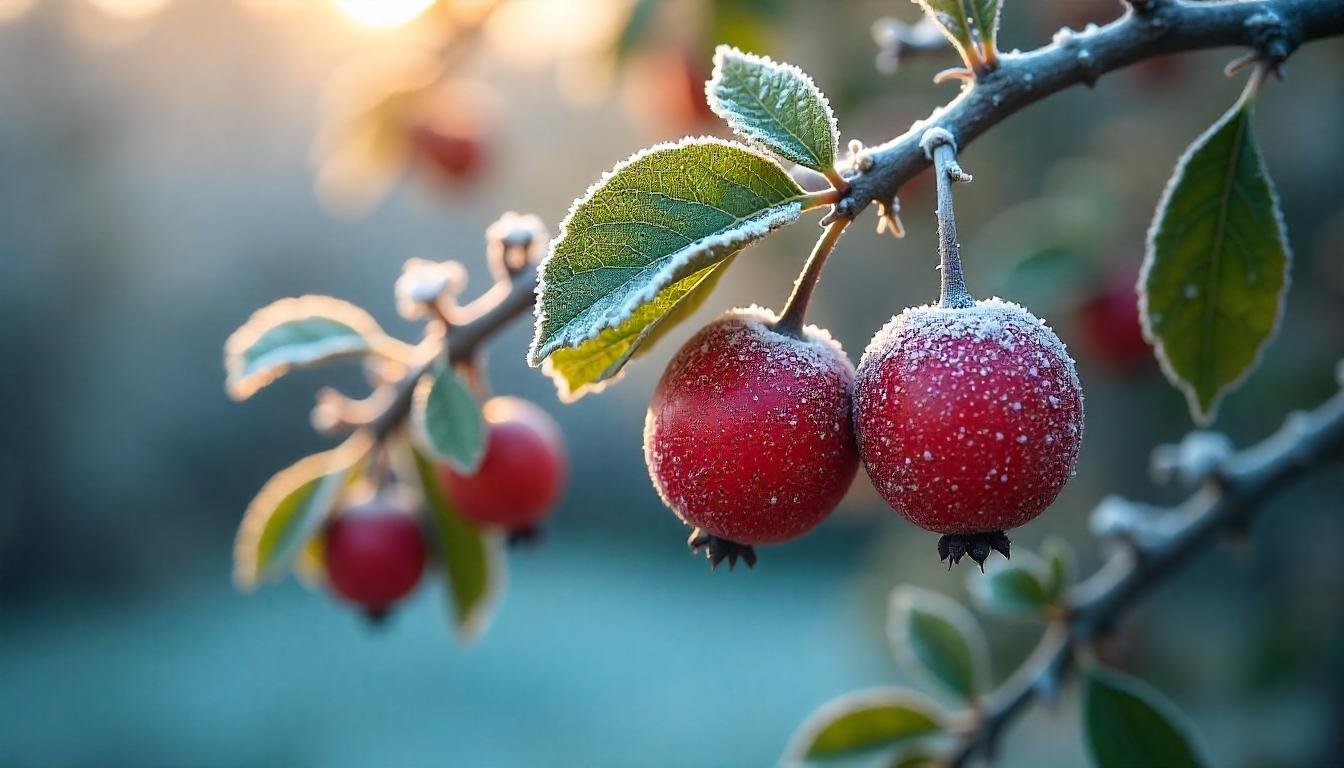Imagine a single fruit boasting twenty times the vitamin C of an orange. Sounds like science fiction, right? Yet, this nutritional powerhouse isn’t a futuristic creation – it’s the humble žižole, cultivated for millennia and hiding in plain sight. Often overlooked in Western supermarkets, these incredible fruits, also known as jujubes or Chinese dates, offer a delightful crunch when fresh and a chewy, date-like sweetness when dried. More than just a tasty snack, žižole are steeped in tradition and bursting with benefits modern science is only beginning to fully appreciate. Let’s uncover the secrets of this ancient superfruit.
The Timeless Journey of the Žižole Tree
The story of žižole begins over 4,000 years ago in the fertile valleys of China. Revered not just for sustenance but for their medicinal properties, these fruits quickly became a cornerstone of traditional Chinese medicine (TCM). The hardy Ziziphus jujuba tree thrived, its cultivation spreading like whispers on the wind.
From Ancient Orchards to Global Groves
Centuries of trade along the Silk Road carried žižole seeds far beyond China. They found welcoming climates across Asia – Korea, Japan, India – and eventually reached the sun-drenched shores of the Mediterranean. Today, you’ll find žižole trees flourishing from Iran and Turkey to Italy and Spain, adapting remarkably well to diverse conditions. This global journey speaks volumes about the tree’s resilience and the universal appeal of its fruit.
A Fruit By Many Names
Depending on where you are, you might hear žižole called by different names:
- Jujube: The most common English name.
- Chinese Date: Reflecting its date-like appearance and texture when dried.
- Red Date: Another common term, especially in Asian markets.
- Tsao/Annab: Regional names used in various cultures.
No matter the name, the remarkable fruit remains the same.
Unlocking the Nutritional Treasure Chest of Žižole
Don’t let their modest size fool you. Žižole are nutritional dynamos, concentrated sources of vital nutrients that support overall well-being.
Vitamin C: The Staggering Star
This is where žižole truly shines. Fresh žižole contain astronomically high levels of vitamin C – research suggests up to 20 times more than citrus fruits like oranges or lemons per 100 grams! This potent antioxidant is crucial for a robust immune system, glowing skin (collagen production), and fighting free radicals. Even dried žižole retain a significant amount, making them a fantastic immune-boosting snack year-round.
Essential Minerals & More Goodness
Beyond vitamin C, žižole deliver a spectrum of essential minerals:
- Potassium: Vital for heart health and regulating blood pressure.
- Iron: Key for oxygen transport and preventing fatigue.
- Magnesium & Calcium: Important for bone health, muscle function, and nerve signaling.
- Phosphorus: Supports energy metabolism and cell structure.
Powerful Plant Compounds (Phytonutrients)
Žižole are rich in bioactive compounds that contribute significantly to their health-promoting reputation:
- Flavonoids: Potent antioxidants that combat inflammation and may protect against chronic diseases.
- Saponins: Known for their immune-modulating and potential cholesterol-lowering effects.
- Polysaccharides: Complex carbohydrates studied for their immune-boosting and gut-health benefits.
Fresh vs. Dried: A Nutritional Snapshot
Here’s a quick look at how the form changes the profile slightly (values are approximate per 100g):
| Nutrient | Fresh Žižole | Dried Žižole | Key Difference |
|---|---|---|---|
| Calories | ~79 kcal | ~287 kcal | Drying concentrates sugars |
| Vitamin C | Very High | Moderate-High | Some loss during drying |
| Fiber | Moderate | High | Significantly increases |
| Sugar | Moderate | High | Concentrated during drying |
| Iron/Potassium | Good Source | Excellent Source | Minerals become more concentrated |
Why Your Body Will Love Žižole: Proven Health Perks
For over four millennia, traditional healers have harnessed the power of žižole. Modern research is now validating many of these ancient uses, uncovering the science behind the benefits.
Boosting Your Body’s Defenses
That massive dose of vitamin C in fresh žižole is your immune system’s best friend. It stimulates the production and function of white blood cells, your body’s frontline soldiers against infection. Combine this with the immune-modulating effects of saponins and polysaccharides, and you have a powerful natural ally for staying healthy, especially during cold and flu season. Think of žižole as nature’s immune-boosting chews.
Soothing Digestion Naturally
Both TCM and modern users turn to žižole for digestive comfort. Their fiber content (especially high in dried fruits) promotes regularity and feeds beneficial gut bacteria. Compounds like saponins and triterpenoids are believed to have gentle anti-inflammatory effects on the gut lining, potentially easing discomfort and bloating. Many find a few dried žižole after a meal helps soothe the stomach.
Fighting Free Radicals & Reducing Inflammation
The potent cocktail of vitamin C, flavonoids, and other antioxidants in žižole makes them formidable free radical scavengers. Free radicals damage cells and contribute to aging and chronic diseases. By neutralizing them, žižole help reduce oxidative stress and chronic inflammation – underlying factors in conditions like heart disease, arthritis, and even some cancers. It’s like internal armor against daily wear and tear.
Promoting Calm & Better Sleep
Traditionally, žižole are renowned for their calming properties. Compounds like flavonoids and saponins may interact with neurotransmitters in the brain, promoting relaxation and reducing anxiety. In TCM, they are often used in formulas to nourish the heart and calm the spirit (Shen), frequently recommended for restlessness and insomnia. Enjoying a cup of žižole tea in the evening is a popular ritual for winding down. Maria, a yoga instructor from California, swears by them: “A handful of dried jujubes and some chamomile tea is my non-negotiable bedtime ritual for deeper sleep.”
Supporting Heart Health & Blood Flow
The mineral profile of žižole – particularly potassium and magnesium – plays a key role in cardiovascular health. Potassium helps regulate blood pressure by counteracting sodium, while magnesium is essential for healthy heart muscle function and blood vessel relaxation. The antioxidant effects also contribute by protecting blood vessels from damage. Some studies suggest compounds in jujube may even help manage healthy cholesterol levels.
From Snack to Gourmet: Delicious Ways to Enjoy Žižole
Žižole are incredibly versatile, moving far beyond a simple handful of dried fruit. Their unique sweet-tart flavor profile complements both sweet and savory dishes.
Fresh: The Crisp, Juicy Treat
- Enjoy them straight: Wash fresh žižole and eat them like small apples. Their crisp texture and sweet, slightly tart flavor are refreshing.
- Salads: Slice or dice fresh žižole into green salads, grain bowls, or chicken salads for a juicy, unexpected burst of sweetness and crunch.
- Salsas & Chutneys: Finely chop fresh žižole and combine with ingredients like red onion, cilantro, lime juice, and a touch of chili for a unique salsa. They also work beautifully in cooked chutneys.
Dried: The Chewy Powerhouse
- On-the-Go Snack: The simplest and most popular way! Keep a bag of dried žižole in your purse, desk, or gym bag for instant energy and nutrition.
- Trail Mixes: Combine dried žižole with nuts, seeds, and maybe a few dark chocolate chips for a satisfying, nutrient-dense mix.
- Baking: Chop dried žižole and add them to muffins, cookies, breads, or energy bars as a healthier alternative to raisins or dates.
- Stews & Tagines: Add whole or halved dried žižole to meat stews, vegetable tagines, or rice dishes (like pilaf) during the last 20-30 minutes of cooking. They plump up beautifully and add a lovely sweetness.
Beyond the Fruit: Teas, Tonics & More
- Žižole Tea: Simmer dried žižole in water for 15-20 minutes to make a naturally sweet, soothing tea. Often combined with goji berries, chrysanthemum, or ginger. Strain and enjoy warm or cold.
- Jujube Vinegar: A traditional tonic made by fermenting žižole, believed to aid digestion and boost energy.
- Powders & Extracts: Concentrated forms are available in health food stores and online, easily added to smoothies, yogurt, or oatmeal.
Chef’s Inspiration: A Simple Žižole & Almond Energy Bite Recipe
“These no-bake bites are my go-to pre-yoga snack,” says Chef Elena Rossi. “The žižole offer natural sweetness and sustained energy, while the almonds add crunch and protein.”
- Blend 1 cup pitted dried žižole, 1 cup raw almonds, 2 tbsp chia seeds, 2 tbsp almond butter, 1 tsp vanilla, and a pinch of sea salt in a food processor until finely chopped and sticky.
- Roll into tablespoon-sized balls.
- Optional: Roll in shredded coconut or cocoa powder.
- Chill for 30 minutes. Store in the fridge.
Finding and Choosing the Best Žižole
Ready to try this superfruit? Here’s how to find them and pick the best.
Where to Hunt for Žižole
- Asian Grocery Stores: Your best bet! Look in the fresh produce section (seasonally) and the dried fruit/nuts aisle. They might be labeled as Jujubes, Chinese Dates, Red Dates, or Hong Zao.
- Health Food Stores: Increasingly common, especially organic dried žižole and sometimes powders/extracts.
- Farmers Markets: In regions where they are grown (like parts of California or the Mediterranean), you might find fresh žižole in season (late summer/fall).
- Online Retailers: Numerous online stores specializing in dried fruits, nuts, superfoods, or Asian ingredients offer a wide variety.
Selecting Top-Quality Fruits
- Fresh Žižole: Look for plump, smooth-skinned fruits with a vibrant reddish-brown hue (color varies by variety). Avoid any with bruises, soft spots, or wrinkles. They should feel firm but not rock-hard.
- Dried Žižole: Choose plump, slightly shiny pieces. Avoid bags with excessive broken pieces, dust, or those that look overly dry, shriveled, or crystallized (signs of age or poor storage). They should be slightly sticky but not wet.
Storing Your Superfruit Bounty
- Fresh Žižole: Store in a perforated plastic bag in the refrigerator crisper drawer. They are best consumed within a week or two. For longer storage, wash, pit, and freeze.
- Dried Žižole: Keep in an airtight container in a cool, dark, dry place (like your pantry). They will last for several months. For very long-term storage (over a year), keep them in the refrigerator or freezer in an airtight container.
Bringing Žižole Magic Into Your Daily Life
Incorporating žižole into your routine is simple and rewarding. Here are three easy ways to start reaping the benefits today:
- Swap Your Afternoon Sugar Crash: Replace candy bars or cookies with a small handful (5-7) of dried žižole. Their natural sweetness satisfies cravings, while the fiber and nutrients provide sustained energy without the crash.
- Brew a Calming Evening Cup: Simmer 5-7 dried žižole (pitted) in 2 cups of water for 15-20 minutes. Strain, sip warm, and unwind. Add a slice of ginger or a pinch of cinnamon for extra warmth.
- Boost Your Breakfast: Chop 2-3 dried žižole and stir them into your morning oatmeal, yogurt, or smoothie bowl. They add sweetness, chewiness, and a powerful nutrient kick-start to your day.
Žižole are far more than just an ancient curiosity. They are a delicious, versatile, and incredibly nutritious gift from nature, validated by both millennia of traditional use and emerging modern science. Whether you crave their crisp freshness, enjoy their chewy dried sweetness, or sip them in a soothing tea, these remarkable fruits offer a simple path to enhanced well-being.
Have you tried žižole yet? What’s your favorite way to enjoy this ancient superfruit? Share your experiences and recipes in the comments below!
You May Also Read: Buší: Unveiling the Rich Tapestry of a Word
FAQs
Are žižole the same as the jujube candies?
No! The chewy candies called “jujubes” share the name but are typically just sugar, corn syrup, and gelatin. Real žižole are the whole fruit from the Ziziphus jujuba tree and offer significant nutritional benefits.
Can I grow a žižole tree in my backyard?
Possibly! Žižole trees are hardy and adaptable. They thrive in warm, sunny climates (USDA zones 6-10 typically) and are drought-tolerant once established. Check your local nursery for varieties suited to your region.
Do žižole have any side effects?
Žižole are generally safe for most people when consumed as food. However, due to their high fiber content, eating large amounts of dried žižole initially might cause mild digestive upset (gas, bloating). Start with small portions. If you take blood sugar or blood pressure medication, consult your doctor, as žižole may potentially interact.
Are fresh or dried žižole better for you?
Both offer benefits! Fresh žižole have much higher vitamin C levels. Dried žižole have concentrated minerals, fiber, and calories. Including both in your diet is ideal, depending on availability and your needs.
How many žižole should I eat per day?
There’s no strict rule. A typical serving is about 1/4 cup of dried žižole (roughly 5-7 fruits) or a small handful of fresh ones. Listen to your body and enjoy them as part of a balanced diet.
What do žižole taste like?
Fresh žižole have a crisp texture similar to an apple, with a sweet, mildly tart flavor sometimes described as apple-pear. Dried žižole are chewy and sweet, closely resembling dates but often with a slightly more complex, caramel-like note.
Where does the name “žižole” come from?
“Žižole” is believed to be a regional name derived from the scientific genus name Ziziphus, used particularly in some Mediterranean areas like Slovenia and parts of Italy. It highlights the direct connection to the botanical source.









